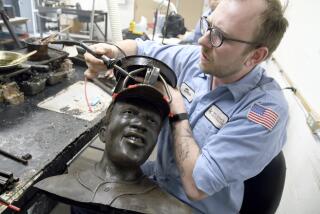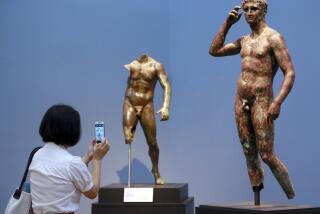‘Lizard’ raises a classic query
- Share via
Is the Cleveland Museum of Art’s new acquisition, “Apollo the Lizard Slayer,” an exceedingly rare and valuable work by the classical Greek sculptor Praxiteles? Or is the 5-foot-tall bronze a Roman copy of the great Greek’s artistry?
A year of study persuaded museum Director Katharine Lee Reid and curator Michael Bennett that the sculptural depiction of a young man preparing to kill a lizard matches a Praxiteles work described by Roman historian Pliny the Elder, but the truth may never be known.
Meanwhile in Los Angeles, news of Cleveland’s purchase has raised another question: Why didn’t the J. Paul Getty Museum buy the sculpture? The price has not been disclosed, but the Getty has a lot more money than the Ohio museum. What’s more, “Apollo the Lizard Slayer” would look terrific at the Getty’s villa in Pacific Palisades, scheduled to reopen in fall 2005 as a museum and study center for antiquities.
The art world’s inquiring minds want to know: Did Getty specialists doubt the authenticity of the sculpture? Are there too many gaps in its provenance to satisfy the museum’s criteria for acquiring antiquities? Or did the Getty shy away from the seller?
Cleveland bought the bronze from Phoenix Ancient Art, which maintains galleries in Geneva and New York. The gallery owners, brothers Hicham and Ali Aboutaam, are leading antiquities dealers, but they have run afoul of the law.
Hicham Aboutaam recently pleaded guilty to a federal charge that he had falsified a U.S. Customs document by claiming that an ancient silver drinking vessel he had imported from Iran came from Syria. Earlier this year, an Egyptian court convicted Ali Aboutaam in absentia of smuggling antiquities and sentenced him to 15 years in prison.
In accordance with standard museum policies, the Getty doesn’t talk about potential acquisitions, and “Apollo the Lizard Slayer” is no exception. That won’t stop speculation, but at least the scholarly issues involved will get an airing at the Cleveland museum’s symposium scheduled for April 2006.
More to Read
The biggest entertainment stories
Get our big stories about Hollywood, film, television, music, arts, culture and more right in your inbox as soon as they publish.
You may occasionally receive promotional content from the Los Angeles Times.










